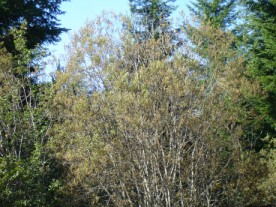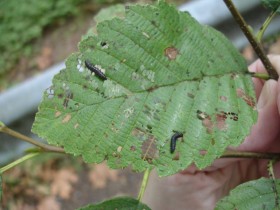
by: Karen Ripley, Forest Health Program Manager, DNR
karen.ripley@dnr.wa.gov
Several reports of damaged willow and alder have reached DNR’s Forest Health program in Olympia recently, including many western Washington observations made by the aerial surveyors Aleksandar Dozic (DNR) and Ben Smith (US Forest Service). The aerial surveys can be viewed by clicking here.
From a distance, the willow trees that have been damaged appear to be reddish-bronze color and missing a lot of foliage. The damage is inconsistent, with some willows heavily affected, and nearby trees without damage. Upon closer examination, the remaining leaves of affected willow trees have been partly skeletonized. The fleshy leaf tissue has been eaten away, leaving just the vein network, which quickly dries to reddish brown. Most leaves have green, undamaged areas adjacent to patches where feeding occurred. I took the photos accompanying this article near Belfair, along the in the Kitsap-Mason County border, on July 18. The damage is spread throughout the crowns.
Alder leaves don’t have as fine a vein network as willow. Affected alder leaves tend to have less of a browned, skeletonized look, and more large holes. The heaviest damage is in the lower parts of the crowns. I took the alder photos near Olympia on July 24.

Damaged willow and alder leaves may also be occupied by grubby black insect larvae. (Yes, beetle larvae are often called “grubs” but “grubby” is doubly suitable because the larvae produce a little webbing that collects dirt, leaf fragments and specks of dark feces where they are feeding. Hence, the descriptor “grimy” or “dirty” is appropriate in addition to the insect itself being an immature beetle “grub”). Larvae look somewhat like black lady beetle larvae, with a head, six short legs and a long, tapering body.
These insects are “leaf beetles” in the family Chrysomelidae. On the willow it is probably the “Pacific willow leaf beetle” Pyrrhalta decora carbo. Adults are dull black beetles with a roughly oval shape and prominent antennae. This species is found across North America, with a gray variety Pyrrhalta decora decora typical in Alberta and Saskatchewan. It also feeds on alder, but the most common alder leaf beetle is the “alder flea beetle” Altica ambiens which matures into a shiny metallic blue-black beetle.

The alder flea beetle’s life cycle is as follows:
- Adult beetles overwinter in the leaf litter below the trees and emerge in the spring to feed and lay batches of yellow eggs on the new foliage.
- The eggs hatch and larvae skeletonize leaves, with activity peaking in early August.
- The larvae pupate in the duff beneath the trees.
- New adults feed voraciously in late summer and fall, chewing holes in the foliage, until they drop to the forest floor and enter hibernation for the winter.
I would appreciate it if people kept watch on their willow and alder this year and reported their observations to me at: karen.ripley@dnr.wa.gov. As you make your observations ask yourself: Is there any defoliation activity? Are larvae or beetles present? Is the life cycle of the willow leaf beetle parallel with that of the alder flea beetle? Particularly, if there are grimy black larvae eating the willow or alder foliage in your neighborhood now, jot down reminders on your calendar to return and look closely several more times over the next couple of months. Especially when the larvae have disappeared and new foliage continues to be produced along the twigs, note whether/when you see adult beetles and what kind of feeding they do (holes, chewing in from the sides, or fresh skeletonizing). Please take digital pictures and send them, too. Photographs are an excellent tool to report and share the insects and damage you see without struggling over exact words. Collect some adult beetles and put them in the freezer. Taxonomists need adult beetles in order to confirm exactly which species is present.
I’ll also be keeping a closer eye on leaf beetle activity on willow and alder the rest of this summer. Let’s see what we can learn together.

One thought on “Willow Leaf Beetle in Western Washington”
Comments are closed.